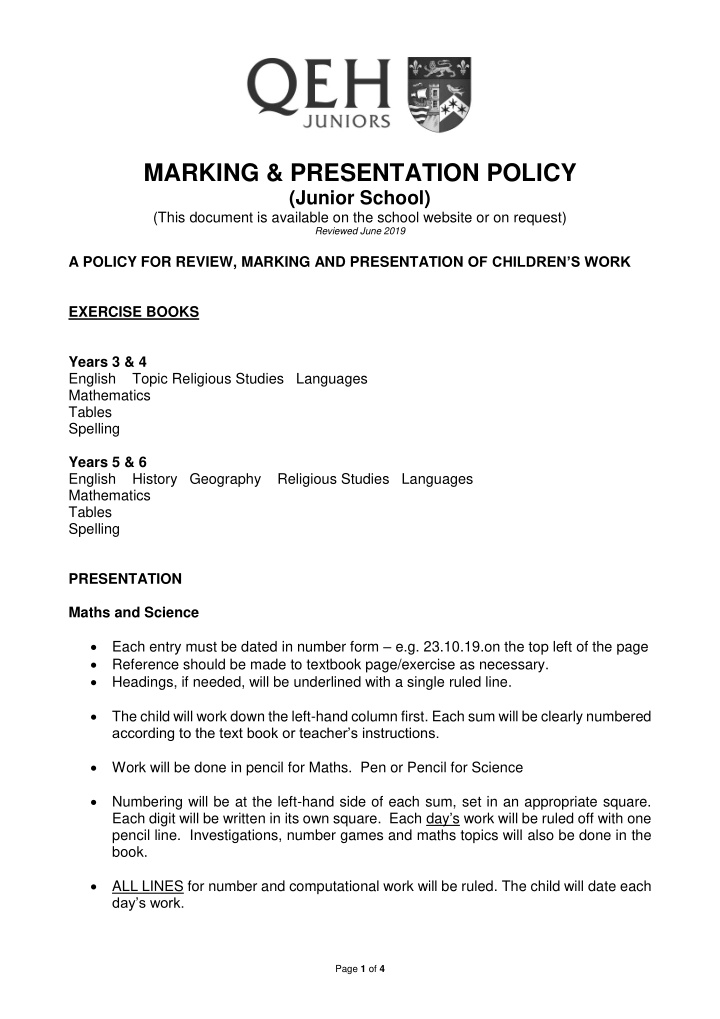



MARKING & PRESENTATION POLICY (Junior School) (This document is available on the school website or on request) Reviewed June 2019 A POLICY FOR REVIEW, MARKING AND PRESENTATION OF CHILDREN’S WORK EXERCISE BOOKS Years 3 & 4 English Topic Religious Studies Languages Mathematics Tables Spelling Years 5 & 6 English History Geography Religious Studies Languages Mathematics Tables Spelling PRESENTATION Maths and Science Each entry must be dated in number form – e.g. 23.10.19.on the top left of the page Reference should be made to textbook page/exercise as necessary. Headings, if needed, will be underlined with a single ruled line. The child will work down the left-hand column first. Each sum will be clearly numbered according to the text book or teacher’s instructions. Work will be done in pencil for Maths. Pen or Pencil for Science Numbering will be at the left-hand side of each sum, set in an appropriate square. Each digit will be written in its own square. Each day ’ s work will be ruled off with one pencil line. Investigations, number games and maths topics will also be done in the book. ALL LINES for number and computational work will be ruled. The child will date each day’s work. Page 1 of 4
English, History, Geography, RS The drafting process for all written work will be introduced in all year groups. The English book will have lined white pages with a margin. It should be emphasised that it is not a rough book and thus all work should be presented neatly according to the school policy. Each new piece of work must be dated – DAY, NUMBER, MONTH e.g. Monday 23 rd October 2017 The date will be written in the top left hand side of the page. The date will be underlined with one ruled line. The title/heading for the work will be centred on the line below the date. Each completed piece of work will be ruled off with a single line. Underlining All underlining must be done with a ruler or straight edge. When underlining in fountain pen the children should turn the ruler over, using the bevelled edge to avoid smudges. Marking It is our aim that as much marking as possible should be done with the child whilst discussing the work in context. Verbal feedback dealing with whole class issue or individual concerns is of immense value and helps the pupil to progress. We also use peer assessment and self-assessment for feedback. All marking will be done in an ink of a different colour to the pupil’s work. Errors made by the child in any form of writing will be underlined or circled Correct work will be indicated by ticks as appropria te, accompanied by the teacher’s comments. Pupils need to be able to understand the feedback and act upon them. Pupils may add their own feedback to reflect on comments. MATHEMATICS I ncorrect work will be marked with a ‘x’. Teachers may ask children to re-write incorrect workings and answers in their marking if necessary. Teachers should indicate in their marking where they have discussed a particular working or helped them to reach an answer/solution. All maths work in exercise books should be done in pencil. Page 2 of 4
ENGLISH Spelling In a child’s developmental writing there will be many spelling and other errors. Teachers will be discriminating according to each child’s writing and spelling development a s to the intensity of marking. During the early stages of writing it will be necessary for teachers to transcribe much of e ach child’s work. Transcriptions will be in the cursive handwriting style on the page opposite the piece of work or directly above it. Spelling errors of words that the teacher considers the child should know will be indicated by underlining the word and entering ‘sp’ in the margin. The child will then re-write the corrected work above the error or on the opposite page. Other spelling errors will be underlined and written correctly in the margin or on the opposite page of the draft book. Grammar and Punctuation If a child’s work does not make sense, it will be underlined or circled with an appropriate comment in the margin or on the opposite page of the draft book. If there is an omission in a piece of work the symbol ^ will be inserted. A numbered asterisk e.g. *1 will be used to indicate an insert by the teacher written on the opposite page. Words not needed in the sentence will be crossed through with one line e.g. and. Whenever possible the teacher will correct grammatical and punctuation errors with the child. Otherwise these will be corrected on the work by the teacher and explained on the opposite page. Page 3 of 4
Appendix 1 Layout for English, Geography, History and RS work. 1 st st Oct ctob ober 2 r 2019 ( Miss a line) The he Ha Haunt unted d Hou ouse se ( Miss a line ) Start work here Layout for Maths and Science Work 1.10. . 2019 (miss a line) Pag age 2 23 ( Miss a line ) Start Work Here Page 4 of 4
Recommend
More recommend